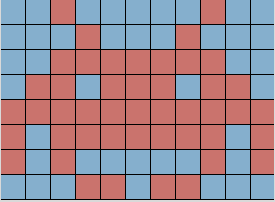The HackR hackathon was a lot of fun and had some really great results. The proceedings are now online here. Thanks to everyone for a great event!
ASARG Sponsored Research Hackathon
ASARG is sponsoring a research hackathon, which is like a 24-hour workshop, where teams of students work on problems and write a short paper. The event is free for students with shirts, prizes, food, etc. It will be held December 1-2 at Nerdvana. We’re only allowing around 60 students, so register as soon as possible. The event page is here: utrgv.hackresearch.com.
David Dittman
Full Tilt: Universal Constructors for General Shapes with Uniform External Forces
Title: Full Tilt: Universal Constructors for General Shapes with Uniform External Forces
Authors: Jose Balanza-Martinez, David Caballero, Angel A. Cantu, Luis Angel Garcia, Austin Luchsinger, Rene Reyes, Robert Schweller, and Tim Wylie
Conference: The 30th ACM-SIAM Symposium on Discrete Algorithms (SODA’19), 2019.
Abstract:We investigate the problem of assembling general shapes and patterns in a model in which particles move based on uniform external forces until they encounter an obstacle. In this model, corresponding particles may bond when adjacent with one another. Succinctly, this model considers a 2D grid of “open” and “blocked” spaces, along with a set of slidable polyominoes placed at open locations on the board. The board may be tilted in any of the 4 cardinal directions, causing all slidable polyominoes to move maximally in the specified direction until blocked. By successively applying a sequence of such tilts, along with allowing different polyominoes to stick when adjacent, tilt sequences provide a method to reconfigure an initial board configuration so as to assemble a collection of previous separate polyominoes into a larger shape.
While previous work within this model of assembly has focused on designing a specific board configuration for the assembly of a specific given shape, we propose the problem of designing \emph{universal configurations} that are capable of constructing a large class of shapes and patterns.
For these constructions, we present the notions of \emph{weak} and \emph{strong} universality which indicate the presence of “excess” polyominoes after the shape is constructed. In particular, for given integers $h,w$, we show that there exists a weakly universal configuration with $\mathcal{O}(hw)$ $1 \times 1$ slidable particles that can be reconfigured to build any $h \times w$ patterned rectangle. We then expand this result to show that there exists a weakly universal configuration that can build any $h \times w$-bounded size connected shape. Following these results, which require an admittedly relaxed assembly definition, we go on to show the existence of a strongly universal configuration (no excess particles) which can assemble any shape within a previously studied “Drop” class, while using quadratically less space than previous results.
Finally, we include a study of the complexity of deciding if a particle within a configuration may be relocated to another position, and deciding if a given configuration may be transformed into a second given configuration. In both cases, we show this problem to be PSPACE-complete, even when movable particles are restricted to $1\times 1$ and $2\times 2$ polyominoes that do not stick to one another.
URL:
Bibtex:
Accompanying videos related to the paper
Section 3: Pattern and General Shape Builder
Construction of a Pattern:

Construction of a Drop Shape:

Construction of a Non-Drop Shape:

Section 4: Drop Shape Builder
Section 5: Relocation Gadget
Example of Correct Traversal Through our Relocation Gadget:
This video shows the correct sequence of tilts to traverse our robot through the gadget. Note the closed exit/entrance points of our gadgets do not affect this traversal, and are only there to simplify testing
Example of Incorrect State Traversal Attempt Through our Relocation Gadget:
Here we see the robot trying to traverse our gadget while the gadget is not in the correct state to allow the robot to do so. This is only one of the possible sequences, but no sequence of tilts exists that would allow the robot to traverse through the gadget from this position.
Example of Robot Polyomino Becoming Stuck Through Correct State but Incorrect Traversal Sequence:
Here is an example of the importance of our optimal sequence to traverse through the gadget, although there are many ways to traverse, there are also many ways to enter what we call “stuck” configuration. From these configurations there is no sequence of tilts that would allow the robot to leave the gadget.
Section 6: Reconfiguration Gadget
Example of Correct Traversal Through Our Reconfiguration Gadget:
Example of Moving State Tiles to Reconfiguration Ring:
Here we remove all tiles from the inner section of our gadget and into the “reconfiguration ring”. This property of our gadget is what allows us to achieve a global configuration of our gadgets and classify this problem as a reconfiguration problem.
Example of A System of Reconfiguration Gadgets:
This shows a system of reconfiguration gadgets and the robots traversal through the system. At the end of our traversal we move all our state tiles int the reconfiguration ring and achieve a specific configuration of our entire system.
Example of Traversal Sequences that Preserve Initial State Tile Positions:
The videos here show that we can easily traverse gadgets while maintaining the a small set of positions for our state tiles. We know that from these positions we can traverse the gadget with a sequence that will allow us to keep the positions of our red tiles within this set, while not moving any tiles that started in this set into the reconfiguration ring.
Paper accepted in SODA 2019
Our summer efforts have paid off with our paper being accepted into the 30th ACM-SIAM Symposium on Discrete Algorithms (SODA19). The paper is titled “Full Tilt: Universal Constructors for General Shapes with Uniform External Forces” with the authors Jose Balanza-Martinez, David Caballero, Angel A. Cantu, Luis Angel Garcia, Austin Luchsinger, Rene Reyes, Robert Schweller, and Tim Wylie.
Here is a link to more information on the paper: SODA19
Tile Pattern-Building Games on a Grid are PSPACE-complete
Angel A. Cantu, Arturo Gonzalez, Cesar Lozano, Austin Luchsinger, Eduardo Medina, Fernando Martinez, Arnoldo Ramirez, and Tim Wylie.
The 21st Japan Conference on Discrete and Computational Geometry, Graphs, and Games (JCDCG^3’18), 2018.
Abstract: In this paper, we investigate a certain class of tile-based pattern games through a simplified version of a recent game titled Nonads. We prove that Nonads is PSPACE-complete with a reduction from bounded 2-player constraint logic (Bounded 2CL) even when both players share the same target and there is only one type of playable tile. This has application to any grid-based pattern building game.
Bibtex:
New Members
We want to welcome the new members to the research group. Most of the members from the summer are continuing to work with us: Bryan, Tim, David, and Jose. Mauricio finished his LSAMP scholarship and is continuing with the group in research. Our newest member is Ari, who joins the group as an MS student and had a lot of undergraduate research experience with Dr. Grabowski.
Finally, we want to mention the new faculty member, Dr. Jingru Zhang, who’s expertise is in Computational Geometry. We are excited for the opportunities and knowledge she brings to the group.



